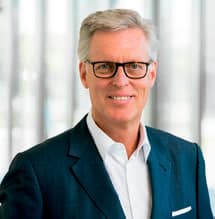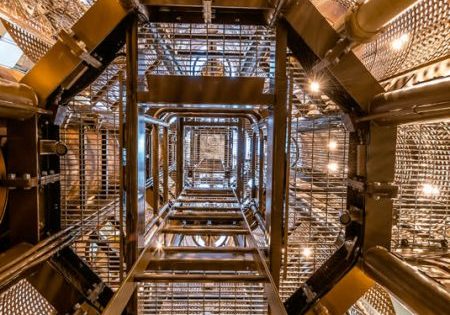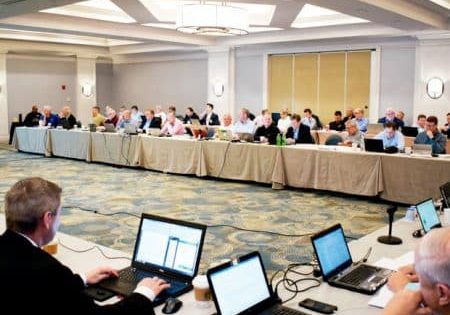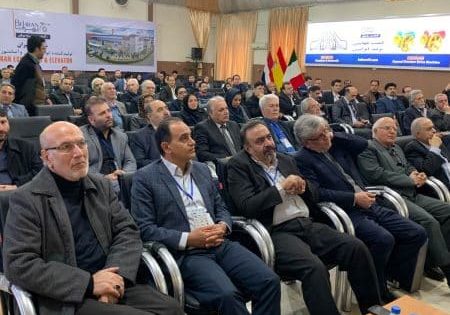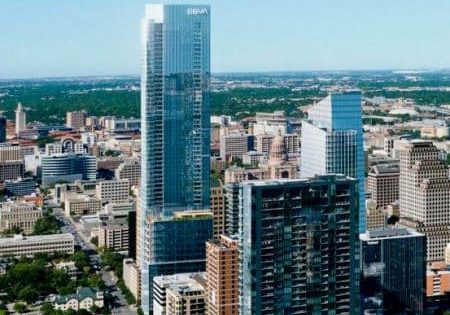A conversation with thyssenkrupp MULTI CEO Michael Cesarz
by Dr. Lee Gray, EW Correspondent photos courtesy of thyssenkrupp
In November 2019, at the Council on Tall Buildings and Urban Habitat (CTBUH) World Congress in Chicago, your author (LG) had the opportunity to talk with thyssenkrupp MULTI CEO Prof. Michael Cesarz (MC) about the origins of the company’s MULTI product, as well as recent developments.
LG: When MULTI was announced in 2014, was the original intention to develop a system that moved vertically and horizontally?
MC: It was not the initial intention. It was a side product, so to speak. We wanted to create something that went in a loop, but if you want to go in a loop, at some point you have to go horizontal. So, when we created the opportunity — the possibility to go horizontal — we said, “OK, if you can go sideways for 3 m, why not go sideways for 30 m or 300?” It was not the intention to go horizontal.
LG: So, initially, it was a modern version of a paternoster elevator?
MC: In a way, yes. MULTI emerged out of three thoughts: The paternoster was one, along with thyssenkrupp’s TWIN technology that features multiple cabins in one shaft. The third was linear motor technology, which showed that what goes horizontal can definitely go vertical. So, when we put everything together, we were very close to MULTI.
LG: What were other important ideas behind the design?
MC: One intention was to have smaller shafts and reduce the number of shafts to create greater efficiency in the building. This allows architects and developers to think about buildings in a different way. On the forefront of our thinking was not the horizontal at all; it was about getting a denser core, making it cleaner and making it less complicated. The limitation factor of the speed of an elevator system is basically the size of the cabin. If you have 25 people in the car with five destinations, the frequency of the stops and length of your journey could drive you crazy. But with smaller cars, you have fewer occupants, which ultimately means fewer stops and a more enjoyable experience.
This is how we started — with the smaller cabin. We had six to seven people in the first version. Now, we’re up to 11-14 people, because the market’s asking us for bigger cabins. But the challenge is, that means slowing down our system, so we are looking at ways we can speed it up again with higher occupancy limits than what we initially intended. (Cesarz then talked about the development of a MULTI app and building sensors that could be used to track occupants or call elevators in advance, both of which could speed operation by dispatching cars in anticipation of their use.)
LG: Can you provide an update on the MULTI installation in the thyssenkrupp test tower?
MC: We have had the first version of the elevator in the test tower for two years. It’s more or less a handmade version, because it was not industrialized. Now, we’re putting in the second version. This version is intended to get to the certification and the license we need to transport people. To ensure MULTI meets all necessary safety requirements, we will run roughly one million km with four cabins to see which components will fail, if any. We are also evaluating which components are too heavy and if we need to take material out. These are all things we are learning as part of the industrialization process.
LG: Does MULTI include other innovations beyond the drive system?
MC: There are a lot of other, related innovations coming, and we will see some spinoffs from MULTI coming to conventional systems. For example, the brakes. We are looking at a ropeless, multilevel brake system, which is the Holy Grail. If you have that, that would be a big issue for conventional elevators. Other innovations involve the doors. While we have conventional doors, ultimately we want them to have optical sensors to help eliminate the noisy connection between the shaft doors and the cabin doors. If you own a Bentley, you don’t want there to be unnecessary noise to disrupt or impact your driving or riding experience. With traditional elevator systems, a normal cabin has to be heavy to create tensions on the pulleys, but we are much lighter. We take every kilogram out to the benefit of transporting more people and, because we transport with the help of linear motors, it’s not about tension.
LG: Could you talk about MULTI’s energy usage and it how compares to that of other systems?
MC: We approach this from two angles. The first angle is energy consumption. To start, you cannot compare the cabins, because we have multiple cabins in the shaft. You have to compare the whole system. If you compare the whole system, as of today, we probably would use maybe 10% more energy than a traditional system. Is this important? Probably not. Why? With conventional elevators, you have a big machine with ropes, and they have an efficiency of 98%, so there is basically no room for improvement. With linear motors you are sitting at 70-75%. As more people are embracing and coming to linear motor thinking, we will see an increase of efficiency, and this will propel us up to an 80% efficiency rate or more within five years. But the energy costs for MULTI are roughly 70% lower than for a conventional elevator.
Why is that? In Europe, for example, you have to pay the price for the peaks in electricity consumption. You step into the cabin and push the button and then the engine starts, it creates the peak and this peak has to be provided by the energy provider 24/7. But, it goes down very fast because the machines are very efficient. For this peak, let’s assume you have to pay roughly 30 cents for a kilowatt hour. You don’t have these peaks in the MULTI because of the constant flow of the current. Thus, your price per kilowatt hour might sit at 12 cents or even less. This is why the total cost for the energy is lower, although the consumption might be 10% higher. However, this is not just about saving money. Sustainability is also central for thyssenkrupp Elevator, and everything we do as an organization has an environmental or green-building component to it.
LG: Is thyssenkrupp still planning to install the first MULTI system in the proposed East Side Tower in Berlin? (The building was designed by Bjarke Ingels Group for OVG Real Estate.)
MC: When unveiling the MULTI prototype in Rottweil in June 2017 (ELEVATOR WORLD, September 2017), we also announced its first customer: The developers of the Berlin East Side Tower, OVG Real Estate, had planned to install the system to showcase their pioneering ideas of future in-house mobility. Due to a new concept of the building, it was recently decided to not implement the MULTI system. However, thyssenkrupp Elevator has a lot of serious requests worldwide for a specific implementation of MULTI in projects. Our pipeline of potential MULTI projects is well filled. Meanwhile, we have identified a new proposed building in Germany.
LG: When will you be announcing the new building?
MC: We hope to have a mutual agreement in hand when we exhibit at Dubai Expo 2020 in October.
LG: How would MULTI be used in the event of a fire or emergency?
MC: If you think about vertical cities or gigatowers with about 60,000 people in a skyscraper that is 1,600 m tall, you quickly understand that evacuating that many people only via staircases will not be sufficient. With more and more tall buildings being planned around the world, we must start thinking about constructing more elevators that will be safe to use in the event of a fire. What can MULTI do? With a roped elevator, there’s not much you can do. thyssenkrupp installed the first occupant evacuation operations (OEO) elevator system in North America, which allows people to use the elevator in the event of an emergency. But what if the fire is in the shaft? The MULTI shaft not only cannot catch fire, but it has a lot of useful sensors. There are smoke and fire and heat sensors that are required in the day-to-day operation of the MULTI system. So, if a fire is detected, we can let the MULTI motors oscillate, going only up and down or in circles, and this provides the opportunity to send people around the location of the fire. This reduces the amount of people using the stairs and reduces the number of floors they have to use the staircase.
LG: CTBUH has conducted numerous investigations into the concept of skybridges. How could MULTI be employed in these settings?
MC: Vertical cities will not replace road traffic, but the horizontally and vertically moving MULTI can serve as a passenger transport system within them and in between buildings that are there — for instance, connected to each by skybridges. The superfast thyssenkrupp ACCEL moving walk could also be installed on skybridges. Whether MULTI or ACCEL, both would greatly improve safety, as you’d separate the traffic systems between people and automobile transportation. ACCEL transports up to 7,200 people per hour per direction at up to 2 m/s.
The tricky part is the current regulation concerning skybridges, especially when two buildings have multiple towers. What do you do with MULTI running via a skybridge in case of a fire if you have to close the doors of the skybridges? We have to find technical solutions for that. The devil is in the details. If you could define skybridges as raised-level public streets, and thus have the municipality or government assume responsibility over them as opposed to the building owners, you might be able to solve some of the regulatory issues. This is new for this industry, but many things are new for this industry. My take on that is that cities are now in the driver’s seat.
Get more of Elevator World. Sign up for our free e-newsletter.
